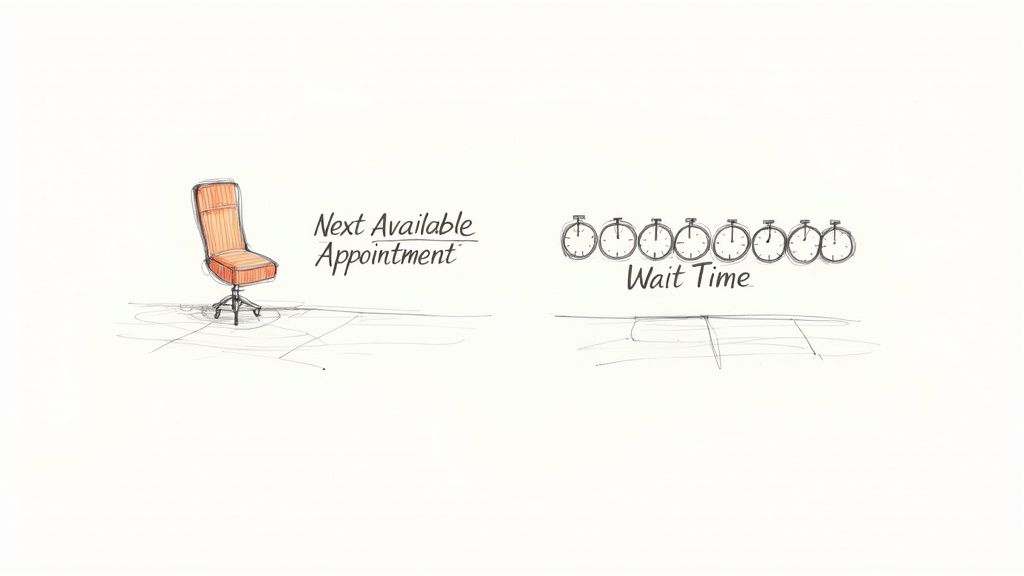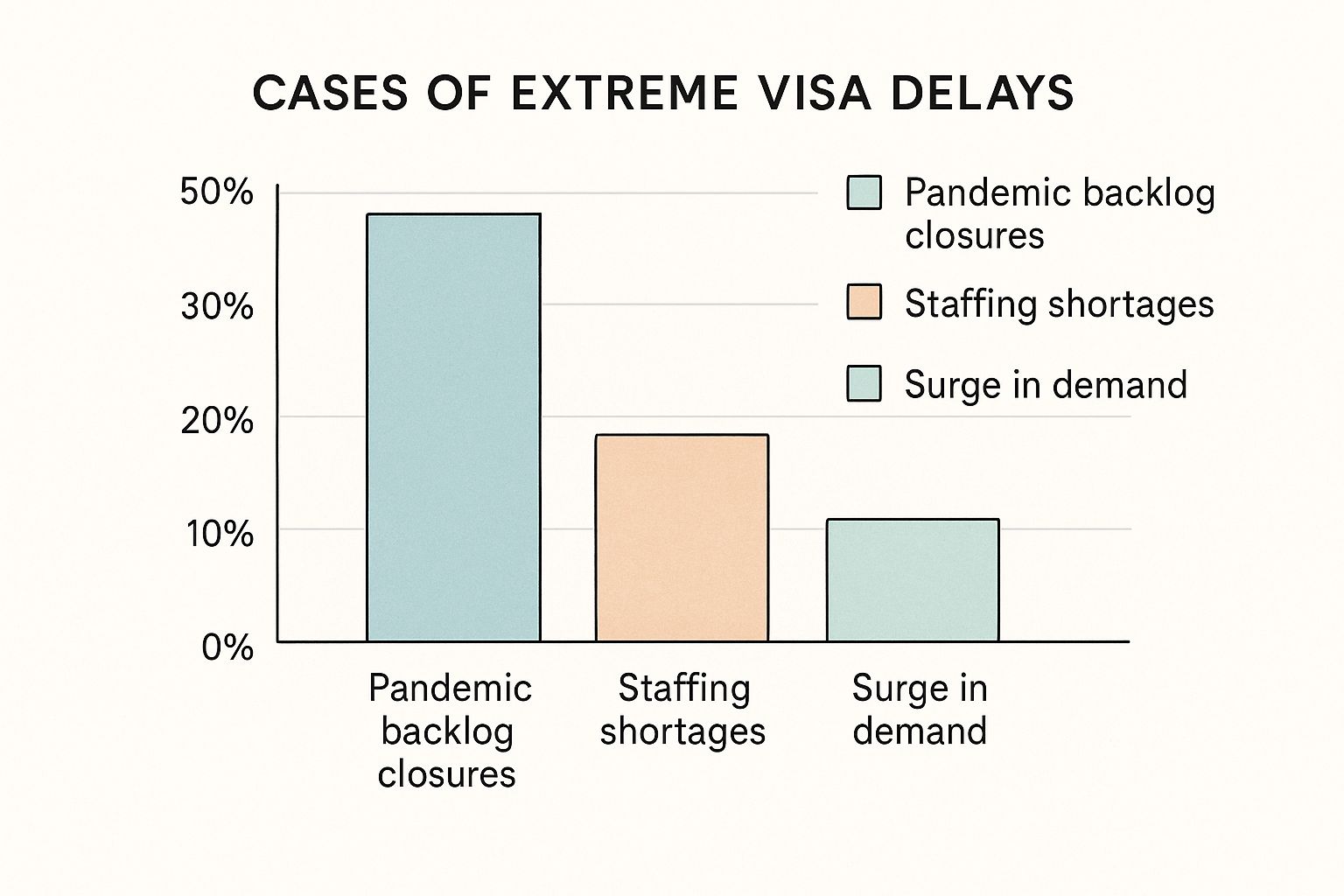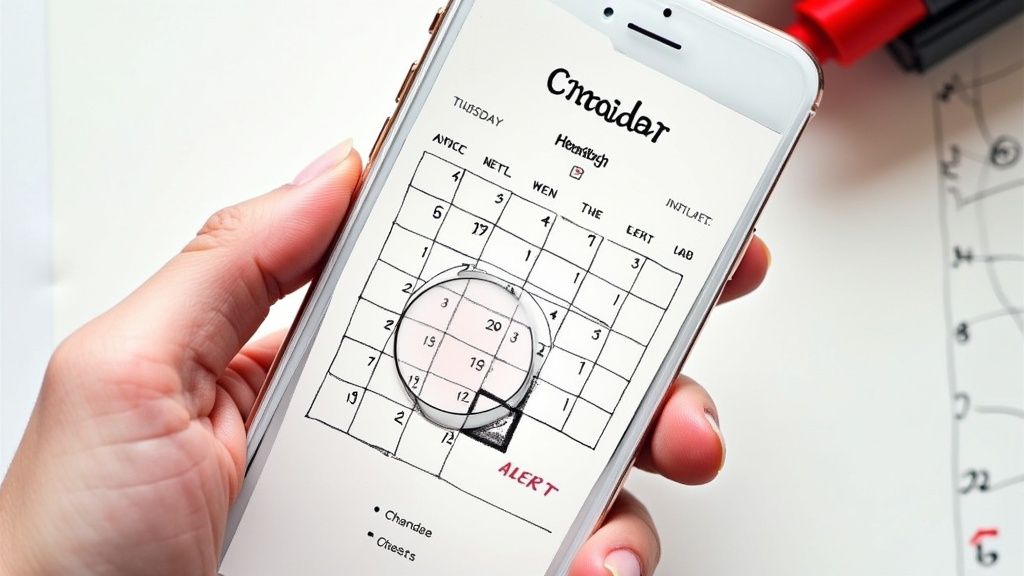If you're applying for a US B1/B2 visa from outside the United States, you’ve probably noticed that US visa appointment wait times are all over the map. They can be as short as a few weeks or stretch out for more than a year. It's a tough situation for international applicants, largely driven by huge post-pandemic backlogs and a worldwide boom in travel.
Decoding the Official Visa Wait Times

Trying to figure out the visa application process can feel like trying to get a last-minute table at a wildly popular restaurant. You know there are tables, but it’s a mystery when one will open up or how long everyone else has been waiting. The first step for any applicant—whether you're in Mexico, Colombia, or an Indian citizen residing in Canada—is learning how the U.S. Department of State actually reports these delays.
To help clear things up, the Department of State recently tweaked how it shares this information. As of April 2024, they started using two distinct metrics for B1/B2 visitor visas, giving applicants a much clearer picture of what to expect. You can read up on the specifics of this visa wait time update on rjimmigrationlaw.com. This simple change helps set realistic expectations by separating the immediate outlook from the recent historical average.
The Two Key Wait Time Metrics
Getting the official lingo down is crucial. The two numbers you’ll see are 'Next Available Appointment' and 'Average Wait Time'—and they paint very different pictures of what's happening at a particular embassy or consulate.
Next Available Appointment: Think of this as the very first open slot on the calendar. It’s the earliest possible date you could snag an interview if you were booking it at this exact moment. This number gives you a real-time snapshot of immediate availability.
Average Wait Time: This metric is more like a look back. It represents the average time applicants waited between paying their fee and their actual interview date over the last month. It's especially handy when wait times are longer than 90 days.
This distinction is vital because the 'Next Available Appointment' can jump around daily thanks to cancellations, while the 'Average Wait Time' offers a more stable, historical view of the backlog.
To give you a clearer understanding, here's a quick breakdown of these two official metrics.
Key Metrics for Understanding Visa Wait Times
| Metric Name | What It Means for You | Where to Find It |
|---|---|---|
| Next Available Appointment | The earliest possible date you could book right now. This is a live, dynamic number. | U.S. Department of State - Visa Appointment Wait Times |
| Average Wait Time | The average time applicants waited last month from payment to interview. A historical lookback. | U.S. Department of State - Visa Appointment Wait Times |
Understanding the difference between these two figures is the first step toward building a realistic timeline and a smart application strategy. One tells you what’s possible today, while the other shows you what most people have recently experienced.
What Is Causing These Extreme Visa Delays?
So, what's really behind these crazy-long US visa appointment wait times? Imagine a massive traffic jam that started during the pandemic when all the roads (consulates) were closed. A huge line of cars (visa applications) built up. Now the roads are open again, but they’re struggling to clear the initial gridlock, and more cars keep joining the back of the line every single day.
That initial shutdown created a backlog of historic proportions, and consular offices are still digging out from under it. But the full story is a bit more complicated than just the pandemic hangover.
The Key Factors Behind the Wait
The delays aren't just from one single problem. It's more like a pile-up of several issues all happening at once. The biggest culprits are:
- Lingering staffing shortages at U.S. embassies and consulates.
- A massive, post-pandemic surge in demand for travel to the US.
- The need to prioritize other types of visas over tourist and business ones.
Think about it from the consulate's perspective. They have a legal and operational duty to process visas for students (F-1), skilled workers (H-1B), and people with urgent humanitarian needs first. That's just how the system works. Unfortunately, this means that B1/B2 applicants for tourism and business often get pushed to the back of the queue, making their wait times stretch out for months, or even years.
This chart gives you a good visual breakdown of what's causing the bottleneck.

As you can see, the pandemic backlog is by far the biggest piece of the pie, but the other factors are still making a major impact.
How Staffing and Policy Changes Impact You
Understaffing is a huge deal. When a consulate is short on consular officers, it directly caps the number of interviews they can physically conduct each day. It doesn't matter if a million people want an appointment; if they only have the staff to see 100, then that's the limit. This is a major reason why US visa appointment wait times are so high in certain countries.
On top of that, we have policy changes that are about to make things even more competitive. The U.S. Department of State has confirmed that starting September 2, 2024, most interview waivers for nonimmigrant visas will be eliminated.
What does this mean for you? It means almost everyone, including many people who could previously renew their visa without an interview, will now have to book an in-person appointment. This is guaranteed to flood the system with even more applicants, all fighting for the same limited number of slots.
The best place to see the current numbers for yourself is the official visa wait time tool on the State Department's website. Just keep in mind that those numbers reflect a system that's under an enormous amount of stress. Knowing what’s happening behind the curtain helps you understand the challenging environment you're navigating.
How Wait Times Differ Around The World

One of the biggest surprises for first-time U.S. visa applicants is discovering that wait times aren't uniform. Not even close. An applicant in Rome might get an appointment in a couple of months, while someone applying from Bogotá could be looking at a wait of over a year.
Think of it like trying to get a table at a popular restaurant. In a small town, you might walk right in. But in a major city on a Saturday night? You're going to be waiting a while.
These wild differences in US visa appointment wait times aren't random. They're a direct reflection of local conditions on the ground. A massive consulate like the one in Mexico City or São Paulo is dealing with a staggering volume of applications that a smaller post just doesn't see. Mix that high demand with the number of available consular officers and regional travel trends, and you get a unique backlog for each specific location.
A Global Snapshot of Wait Times
Looking across the globe, the picture for visa appointments varies dramatically. In 2024, we're still seeing the lingering effects of pandemic backlogs, staffing shortages, and a huge surge in travel demand, all of which create these major differences.
For example, an applicant in Bogotá might be told the next available slot is roughly 600 days away. At the same time, someone in London could find an appointment within 90 days. It really drives home the point that every consulate is working under its own set of pressures. You can find more analysis on these global wait time trends on pubscholars.org.
To put this into perspective, the table below gives a snapshot of what B1/B2 applicants are facing in a few major cities.
Sample B1/B2 Visa Appointment Wait Times by Consulate
A comparative look at estimated wait times in major cities to illustrate global variations.
| City, Country | Estimated Next Available Appointment (Days) | Key Local Factors |
|---|---|---|
| Bogotá, Colombia | 600+ | Extremely high application volume and significant backlogs. |
| Mexico City, Mexico | 500+ | Consistently high demand from a large population of applicants. |
| São Paulo, Brazil | 300+ | Major hub for business and tourist travel, leading to high demand. |
| London, UK | ~90 | Lower relative demand and efficient processing systems. |
| Rome, Italy | ~60 | Moderate application volume and adequate consular staffing. |
Note: These wait times are estimates and can change daily.
As you can see, where you apply from matters—a lot.
Understanding this global perspective is crucial. It helps explain why the wait time at your local embassy is what it is and can even inform strategic decisions, such as considering an application in another country if you are eligible.
Arming yourself with this knowledge helps you set realistic expectations for your own timeline. It also confirms that the long wait you might be facing isn't personal; it's a localized issue, driven by a specific set of circumstances that are often completely out of your hands.
Proven Strategies to Find an Earlier Appointment

It’s an awful feeling to see a visa appointment date that’s months, or even years, down the road. But while the massive backlog is a real problem, you aren't completely helpless. It’s time to shift from passively waiting to actively hunting for a better slot to shorten your US visa appointment wait times.
Think of it like trying to get a ticket to a sold-out concert. Officially, it's full. But people's plans change, and tickets pop up at the last minute. The trick is being at the box office right when one becomes available. The same logic applies to the visa portal—you just need the right approach.
Actively Hunt for Canceled Appointments
New slots and canceled appointments are released at completely random times, and they get snatched up in seconds. Manually hitting "refresh" all day is a surefire way to drive yourself crazy, but a little strategy can go a long way.
- Check During Off-Peak Hours: Most people log in during their local business hours. Try checking very early in the morning or late at night, based on the consulate's time zone. You’ll have a lot less competition.
- Monitor After Holidays: Keep an eye on the portal after major US or local holidays. That’s often when people finalize or cancel travel plans, causing a shuffle in appointments.
- Be Persistent but Careful: You have to be consistent, but don't overdo it. Refreshing the page too aggressively can get your account temporarily locked out.
The name of the game is consistent monitoring. Canceled slots are claimed almost instantly, so success often comes down to being one of the first to see the opening.
If you want to dig deeper into optimizing your search, our guide on US visa appointment booking has more advanced tips.
Requesting an Expedited Appointment
If you're facing a genuine, verifiable emergency, you might be able to get an expedited appointment. This isn't for cutting the line for a vacation or routine business trip; it’s reserved for truly urgent situations. You'll need to book a regular appointment first before the system even lets you request an expedited one.
Legitimate reasons usually involve:
- Urgent Medical Needs: Traveling to the U.S. for life-saving or critical medical treatment.
- Family Emergencies: Attending a funeral or visiting a terminally ill immediate family member (like a parent, sibling, or child).
- Sudden Business Needs: An unexpected business matter where your absence would cause a significant financial loss to a U.S. company.
Be prepared to back up your claim with solid proof, like a detailed letter from a doctor or a formal invitation to an urgent meeting.
Applying as a Third-Country National
Are you living in a country where you aren't a citizen? You may be able to apply from your country of residence as a third-country national (TCN). For instance, an Indian citizen with legal residency in Canada could potentially apply at a U.S. consulate there.
This can be a fantastic option if wait times in your country of residence are much shorter than in your home country. Just be ready to prove you have strong ties to where you live, not just your country of citizenship. The consular officer needs to be convinced you have every reason to return to your current residence after your trip to the U.S.
Critical Mistakes to Avoid During Your Wait
The wait for a US visa appointment can be long and nerve-wracking. It’s a period filled with uncertainty, and that frustration can unfortunately push people into making rash decisions—mistakes that can sink their entire application. Navigating this waiting game smartly is every bit as important as nailing the interview itself.
The most common trap? The promise of a shortcut. You’ll see unofficial "agents" or shady services pop up, claiming they can get you an early appointment for a steep price. My advice is to be incredibly wary of these offers.
These are almost always scams. Handing over your login credentials to a stranger not only exposes your personal data but could get your account flagged or locked by the consulate. Suddenly, you can't even manage your own application.
Steering clear of these promises is the first step toward a successful outcome.
Resisting Costly Financial Gambles
It’s completely understandable to want to get your travel plans locked in. But booking non-refundable flights or paying for accommodation before your visa is actually stamped in your passport is a massive financial gamble.
Given the unpredictable nature of US visa appointment wait times—not to mention the possibility of administrative processing after the interview—nothing is ever set in stone. Your best bet is to either book flexible travel options you can change or cancel, or simply wait until you have that visa in your hand.
Protecting the Integrity of Your Application
When you're feeling desperate, it can be tempting to bend the rules a little to speed things up. This is a huge mistake with serious, long-term consequences.
- Submitting Multiple DS-160 Forms: Some people think filing several applications might increase their chances of finding a faster slot. In reality, it just clogs up the system, creates confusion, and can get your applications canceled. Stick to one, accurate form.
- Fabricating an Emergency: Lying about a family crisis or medical emergency to get an expedited interview is considered serious misrepresentation. If the consulate finds out—and they often do—it will almost certainly lead to a visa denial and could even get you banned from entering the U.S. for years.
If you have a genuine, urgent need to travel, there are official channels to request an expedited appointment. Our guide on how to expedite a US visa appointment walks you through the proper steps with authentic documentation. In this process, honesty and patience are truly your best friends.
Got Questions? We've Got Answers
When you're stuck in a long visa queue, you're bound to have questions. It's a stressful process, and the details matter. Here are some of the most common things people ask while navigating the wait.
Can I Just Pay the Fee and Apply in Another Country?
This is a really common thought: if the wait is shorter in a neighboring country, can I just transfer my visa fee and apply there?
Unfortunately, you can't. The MRV fee (that's the main visa application fee) is non-transferable and non-refundable. It’s tied specifically to the country where you paid it. If you decide to try your luck as a third-country national elsewhere, you'll have to start a brand new application and pay a new fee in that country.
A quick heads-up: The official appointment calendar isn't a static page. It's constantly in flux. Slots open up from cancellations and consulates add new capacity without warning. This is why checking obsessively feels necessary—because wait times can literally change multiple times a day.
What Happens if My Passport Expires While I'm Waiting?
With wait times stretching over a year in some places, this has become a real problem. If your passport is going to expire before your scheduled interview, you absolutely must renew it first. You can't show up with an expired passport.
After you get your new passport, don't forget the crucial next step: log into the visa application portal and update your profile with the new passport number before your interview day. If you skip this, you’re looking at major delays or even being forced to reschedule.
For more on the nitty-gritty of changing your appointment, our guide on how to reschedule a US visa appointment walks you through it.
Tired of hitting the refresh button a hundred times a day? Vast Fisa can take over the search for you. Our tool watches the visa portal 24/7 for earlier openings and can even auto-book a new slot for you the moment it appears. We support B1/B2 applicants in countries like Mexico, Colombia, Brazil, Canada, South Africa, and many more. Stop waiting and start planning your trip at https://www.vastfisa.com.
